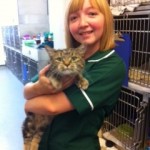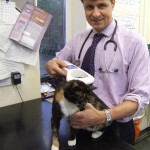Congratulations to Claire, who has just passed her final practical exam in her training to be a qualified veterinary nurse. Both our Ealing and Hounslow surgeries are training centres for veterinary nurses. This involves significant time commitments from our more senior qualified nurses, but is well worth it to maintain our high levels of nursing care for all our patients. To train to be a qualified nurse takes about 3 years of study and practical tests, with 3 theory examinations and one practical exam- it’s a lot of hard work. Qualifying enables her to wear a qualified nurse’s green uniform. Here she is modelling it!
Well done Claire!
Author Archives: gray_ealingvets
10 Interesting cat facts !
The domestication of cats was based on mutual benefit. In the earliest days of agriculture, people were forced to deal with an unforeseen consequence: rodents devouring crops and spoiling the grain. Following voraciously in their footsteps were predators like snakes and owls—and cats. The cats with the friendliest dispositions were eventually welcomed into human settlements, highly valued for their ability to destroy vermin. The house cat was domesticated from the African wildcat approximately 10,000 years ago in the Middle East and has rarely strayed from our side since.
10 Interesting Cat Facts !
- Sir Isaac Newton invented the cat flap
- It was once thought that the ancient Egyptians were the first to tame cats, but a pet cat has since been found in a 9,500 year old grave in Cyprus
- Cats have around 230 bones in their body, while humans only have 203 bones
- According to the 2010 PAW Report there are 11.9 million pet cats living in the UK
- When cats run they can reach speeds of up to 30mph
- According to the Guinness World Records, the oldest cat lived to be 38 years and 3 days
- Chocolate is poisonous to cats
- A person that loves cats is called a ailurophile
- Julius Caesar was scared of cats, a condition known as ailurophobia
- Cats use their whiskers to judge if they can fit through a hole
Microchipping your cat
Microchipping your cat
Microchipping is one of the most effective forms of pet identification, but too few cat owners have their pets microchipped. The 2011 PDSA Animal Wellbeing (PAW) Report has revealed that 54% of cats in the UK are not microchipped. That’s around 6.4 million cats without microchips.
If cats are microchipped, they are more likely to be reunited with their owners because microchipping is a permanent form of pet identification, unlike collars which can become lost. A cat’s microchip can be read in seconds by a handheld scanner at most veterinary practices or animal shelters.
Cats are naturally inquisitive creatures. Some inspect delivery vehicles and are inadvertently locked inside. There are stories of cats that have turned up hundreds of miles from home and are returned to their owners thanks to their microchips.
We offer cat microchipping at our surgeries in West London. The procedure is quick and often painless – your cat won’t even need to be anaesthetised. Using a syringe, the microchip will quickly be inserted under the skin between your cat’s shoulder blades. It takes no longer than giving a normal injection.
Some cats regularly lose their collars, so microchipping could be a cheaper option in the long run. A microchip will stay with your cat for its entire lifetime. Collars are also a potential hazard to cats as they can easily become snagged on things. Dextrous cats can even get their paws caught underneath a collar, which can lead to painful wounds.
If a cat is believed to be a stray and it is brought into our practice, we will immediately scan it to find out if it has a microchip. If the cat can’t be identified, then it could be rehomed, while its real owner is left forever wondering what happened to their beloved pet.
Call Young Veterinary Partnership today or drop into our practice to enquire about microchipping your cat.
Chiswick Young Veterinary Partnership open day
Jack Russell Terrier cross found
Cat found in Turnham Green Chiswick
A cat was found outside our Chiswick surgery. Do you recognise him?
The cat is male, entire, fairly young, not chipped & no collar. Markings are black with 4 white feet, white under chin and white whiskers.
He was found outside our Turnham Green surgery on the 29th April. Please phone Young Veterinary Partnership on 0208 5670711 for further information.
Pet of the Month
Meet Mr Bond, James Bond… Pet of the Month for March. After a mission that must have backfired somewhat, James was brought into the surgery as a stray with a badly broken leg. We assume he was injured by a car during an important assignment, but we cannot be sure as he won’t tell us. He is a secret agent after all…
The femur of his left leg was broken in 2 places (see x-ray) and he was in considerable pain.
Mr Young repaired the fractures by placing pins inside the fractured pieces of bones to hold them together. The pins are held in place by an external fixator (visible on the photo) to ensure the bones will heal together straight.
Now he is in our hospital recuperating from his ordeal and waiting for that special someone willing to give this loving boy a new home! James Bond is approximately 3-4 years old, neutered and, apart from his accident, perfectly healthy. He will need to be cage-rested while the external fixator is still in place (until end of March). Like his human equivalent 007 he has got all female staff at his beck and call and we’re sure he will make a great pet.
To arrange a meeting with Mr Bond, speak to a member of staff.





